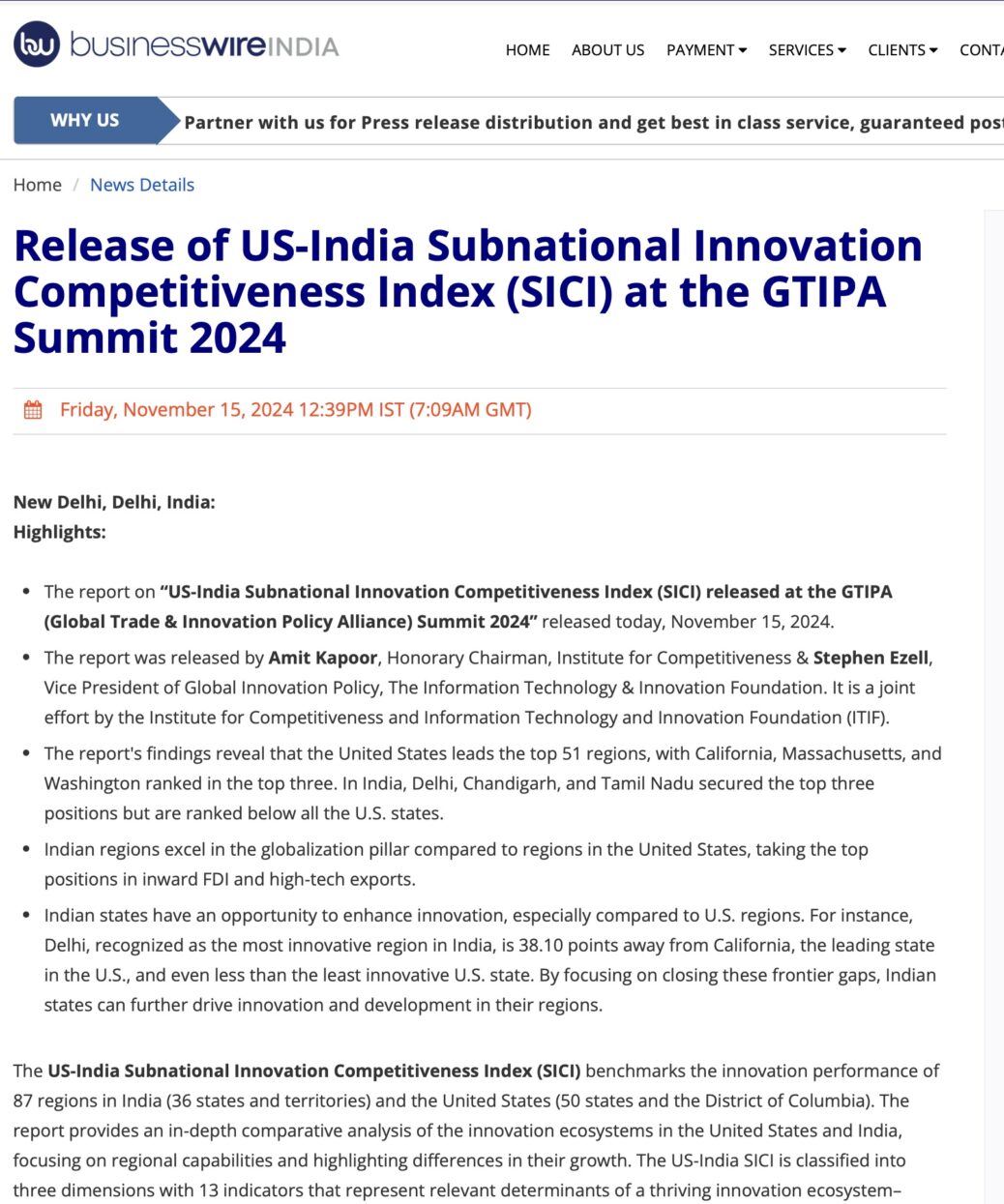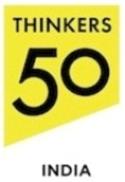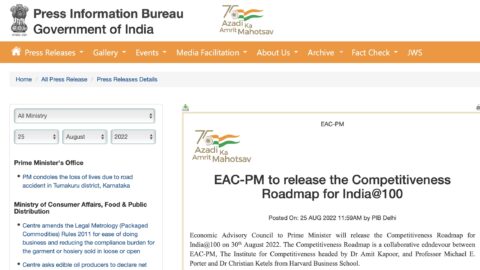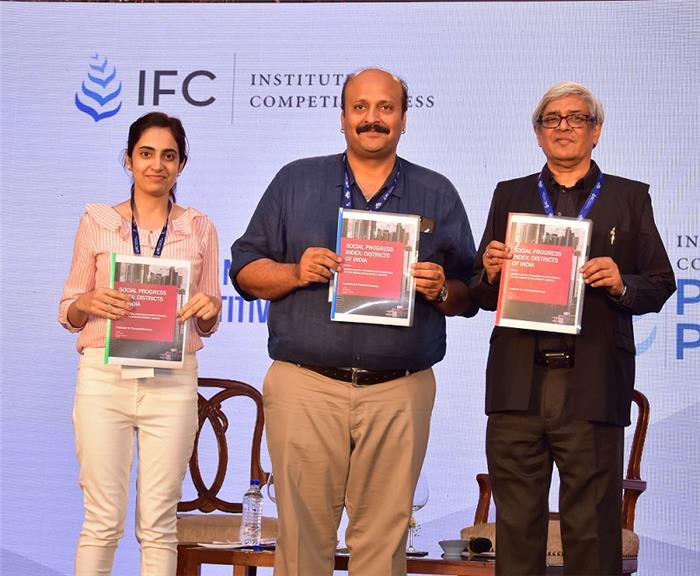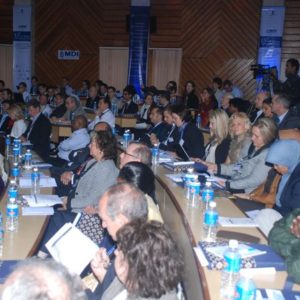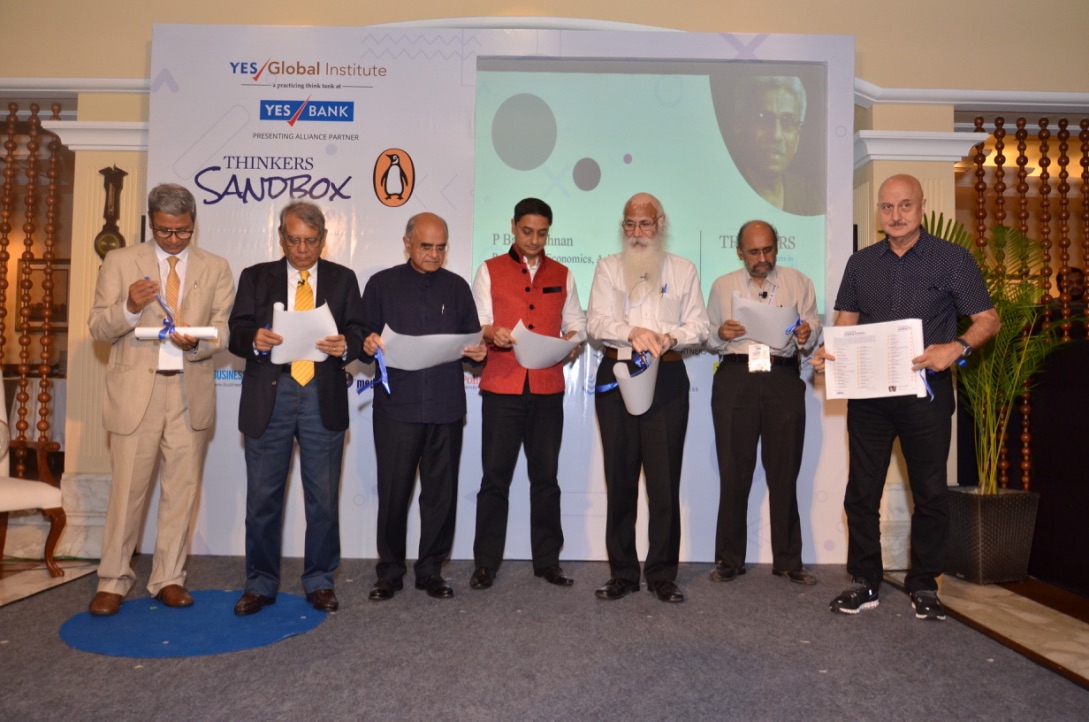New Delhi, Delhi, India:
Highlights:
- The report on “US-India Subnational Innovation Competitiveness Index (SICI) released at the GTIPA (Global Trade & Innovation Policy Alliance) Summit 2024” released today, November 15, 2024.
- The report was released by Amit Kapoor, Honorary Chairman, Institute for Competitiveness & Stephen Ezell, Vice President of Global Innovation Policy, The Information Technology & Innovation Foundation. It is a joint effort by the Institute for Competitiveness and Information Technology and Innovation Foundation (ITIF).
- The report’s findings reveal that the United States leads the top 51 regions, with California, Massachusetts, and Washington ranked in the top three. In India, Delhi, Chandigarh, and Tamil Nadu secured the top three positions but are ranked below all the U.S. states.
- Indian regions excel in the globalization pillar compared to regions in the United States, taking the top positions in inward FDI and high-tech exports.
- Indian states have an opportunity to enhance innovation, especially compared to U.S. regions. For instance, Delhi, recognized as the most innovative region in India, is 38.10 points away from California, the leading state in the U.S., and even less than the least innovative U.S. state. By focusing on closing these frontier gaps, Indian states can further drive innovation and development in their regions.
The US-India Subnational Innovation Competitiveness Index (SICI) benchmarks the innovation performance of 87 regions in India (36 states and territories) and the United States (50 states and the District of Columbia). The report provides an in-depth comparative analysis of the innovation ecosystems in the United States and India, focusing on regional capabilities and highlighting differences in their growth. The US-India SICI is classified into three dimensions with 13 indicators that represent relevant determinants of a thriving innovation ecosystem–
- Knowledge Economy—Indicators measure the number of doctoral degree recipients, the share of employees engaged in science, technology, engineering, and mathematics (STEM) activities, manufacturing labor productivity, the quality of universities, the number of females enrolled in higher education, and the number of R&D personnel.
- Globalization – Indicators measure inward FDI flows and high-tech exports.
- Innovation Capacity – Indicators measure household access to the Internet, the number of new business applications, the number of active businesses, patent output, and expenditures on R&D.
The report analysis of innovative capabilities in the United States and India underscores key policy recommendations to strengthen knowledge economies, address globalization challenges, and expand innovative capacities at regional levels.
The key recommendations of the reports are-
- To strengthen the U.S. knowledge economy, increased investments in R&D across universities, government agencies, and private firms, particularly in nuclear power and AI, are essential. Targeted research grants for underrepresented states and universities can diversify the R&D workforce. Expanding STEM education and specialized programs for middle and high school students will help fill workforce gaps. Amid U.S.-China trade tensions, the U.S. must grow its high-tech sector. The $53 billion CHIPS and Science Act is a promising start in semiconductor R&D, but further workforce development incentives are needed. Enhanced tax incentives for FDI, regional industry clusters, a doubled federal R&D tax credit, and additional credits for advanced machinery and innovation vouchers for SMEs will drive regional competitiveness and innovation.
- To enhance regional innovative capabilities in India’s R&D and STEM sectors, increasing R&D jobs, boosting women’s STEM participation, and creating local programs in underdeveloped areas are crucial to enhance productivity. Expanding FDI and innovation support beyond leading states will promote balanced growth. With R&D spending at just 0.7% of GDP, increased private-sector investment, tax incentives, and public-private partnerships are essential. Adopting the Triple Helix Model for university-industry-government collaboration, particularly in tier 2 and 3 regions, will further build innovative capacity.
- Policymakers must continue strengthening and promoting U.S.-India relations, focusing on building critical and emerging technology and R&D collaboration initiatives, which can further connect start-ups, universities, and venture capital in both nations.
- The report advocates the importance of regional factors in shaping innovation, highlighting that collaboration between academia, government, and industry can support enhancing competitive advantages in countries.
- The report suggests India should adopt competitive, innovation-focused policies like those used in top U.S. states like California and Massachusetts to bridge the innovation gap. In addition, it stresses how India can replicate the factors that have led to these states becoming the forefront of innovation, thereby providing targeted insights into regional strengths and weaknesses and helping India develop more robust strategies that promote competitive growth across its diverse states and territories.
In his Keynote address, Montek Singh Ahluwalia, Former Deputy Chairman, Planning Commission, Government of India, highlighted the relevant roles of the private sector and the government in driving technology. The Keynote address was delivered just before the release of the US-India SICI report.
He also stated, “The policy must ensure that much more research is done. Any data will show that India is not investing nearly enough in research compared to the countries we are trying to catch up with. Within this total, there is distortion in the sense that a much larger proportion of research and development is under Defence and security, including atomic energy and space. In commercial areas, if we look at Research relative to GDP, this is a fraction of what other successful developing countries are doing.” He further emphasized that “We need to open in order to create incentives in the Private sector to bring in technology.”
Stephen Ezell remarked, “Knowing how regions compare in innovation is the first step toward enhancing global competitiveness. This index clearly outlines how regions in the U.S. and India can learn from each other to create powerful innovation ecosystems.” He emphasized that pursuing these initiatives will enable India’s regions to compete more effectively on a global scale, leading to sustained economic growth and a flourishing innovation landscape. With focused and collaborative policy efforts, India’s states can become vibrant centers of innovation and play a crucial role in the global economy.
In his concluding remarks, Amit Kapoor highlighted the opportunity for India to boost its innovative ecosystem at the subnational level by increasing private sector R&D expenditures. He stressed the importance of investing in STEM education to empower future innovators and suggested expanding beyond established regional innovation hubs like Delhi, Karnataka, and Tamil Nadu. By addressing regional disparities, India can harness its demographic dividend and grassroots innovation, aiming for a successful transition to a developed economy by 2047. This strategy promises a brighter future for all. He also said that “Indian states have the opportunity to effectively bridge innovation gaps by implementing targeted, innovation-centric policies at the state level. By drawing inspiration from successful regions in the United States, such as California and Massachusetts, Indian states can significantly advance their competitiveness and close the distance to the frontier of innovation. This collaborative approach will facilitate growth and foster a thriving ecosystem conducive to creativity and technological advancement.”
This report serves as an initial effort to understand the innovative capabilities of both regions at the sub-national level. We will continue to refine this work and improve our methodology as we move forward.
The report has been authored by Amit Kapoor, Chair of the Institute for Competitiveness; Stephen Ezell, Vice President of Global Innovation Policy at The Information Technology & Innovation Foundation; Meghan Ostertag, ITIF; and Sheen Zutshi, Research Manager at the Institute for Competitiveness.
The report can be accessed at: https://www.competitiveness.in/us-india-subnational-innovation-competitiveness-index/
Overall Scores and Ranking:
| Overall Rank | State | Overall Score | Knowledge Economy | Globalization | Innovation Capacity | |||
| Score | Rank | Score | Rank | Score | Rank | |||
| 1 | California | 64.42 | 86.06 | 1 | 6.19 | 35 | 63.95 | 5 |
| 2 | Massachusetts | 63.47 | 75.04 | 2 | 10.16 | 19 | 70.9 | 1 |
| 3 | Washington | 55.43 | 63.35 | 3 | 5.76 | 37 | 65.07 | 3 |
| 4 | Delaware | 49.48 | 47.62 | 23 | 11.43 | 34 | 66.22 | 2 |
| 5 | Wyoming | 48.75 | 46.96 | 25 | 16.36 | 30 | 64.78 | 4 |
| 6 | Oregon | 48.41 | 47.75 | 22 | 3.73 | 11 | 60.14 | 6 |
| 7 | District of Columbia | 46.88 | 52.44 | 13 | 0.99 | 70 | 57.46 | 7 |
| 8 | New Jersey | 46 | 54.44 | 8 | 9.9 | 21 | 50.44 | 13 |
| 9 | Maryland | 45.79 | 56.35 | 6 | 1.59 | 63 | 51.02 | 11 |
| 10 | Texas | 44.94 | 60.23 | 5 | 6.21 | 14 | 41.97 | 28 |
| 11 | New Hampshire | 44.89 | 52.39 | 14 | 4.77 | 28 | 50.66 | 12 |
| 12 | New York | 44.83 | 62.88 | 4 | 7.58 | 51 | 41.84 | 30 |
| 13 | Connecticut | 44.27 | 49.99 | 16 | 5.25 | 31 | 51.74 | 9 |
| 14 | Michigan | 44.09 | 53.7 | 9 | 5.44 | 44 | 48.38 | 15 |
| 15 | Minnesota | 43.3 | 48.9 | 19 | 6.96 | 40 | 51.07 | 10 |
| 16 | Colorado | 42.82 | 50.49 | 15 | 10.31 | 56 | 49.26 | 14 |
| 17 | Illinois | 42.23 | 52.84 | 12 | 4.82 | 17 | 43.17 | 22 |
| 18 | North Carolina | 42.18 | 53.6 | 10 | 5.47 | 39 | 44 | 20 |
| 19 | Pennsylvania | 42.03 | 55.1 | 7 | 3.11 | 47 | 42.44 | 23 |
| 20 | Utah | 41.82 | 49.64 | 17 | 3.47 | 53 | 47.64 | 16 |
| 21 | New Mexico | 41.64 | 39.79 | 39 | 9.87 | 22 | 54.4 | 8 |
| 22 | Indiana | 40.32 | 49.01 | 18 | 10.98 | 15 | 42.18 | 26 |
| 23 | Florida | 40.25 | 48.19 | 21 | 2.91 | 48 | 44.97 | 19 |
| 24 | Virginia | 39.78 | 52.98 | 11 | 6.55 | 57 | 39.95 | 33 |
| 25 | Arizona | 39.32 | 45.32 | 26 | 10.16 | 19 | 43.69 | 21 |
| 26 | Ohio | 38.77 | 47.09 | 24 | 6.38 | 32 | 41.98 | 27 |
| 27 | Wisconsin | 38.05 | 44.76 | 28 | 7.38 | 25 | 41.83 | 31 |
| 28 | Georgia | 37.64 | 44.52 | 29 | 8.64 | 33 | 41.89 | 29 |
| 29 | Idaho | 37.39 | 39.4 | 42 | 1.52 | 55 | 47.34 | 17 |
| 30 | Rhode Island | 37.32 | 44.99 | 27 | 9.1 | 64 | 42.39 | 24 |
| 31 | Vermont | 36.85 | 41.3 | 36 | 3.13 | 23 | 42.22 | 25 |
| 32 | Montana | 36.69 | 40.75 | 37 | 2.19 | 68 | 45.11 | 18 |
| 33 | Missouri | 36.11 | 42.83 | 34 | 3.73 | 59 | 41.44 | 32 |
| 34 | North Dakota | 36.06 | 44.02 | 30 | 7.39 | 51 | 39.67 | 34 |
| 35 | Iowa | 35.92 | 43.99 | 31 | 3.25 | 29 | 38.11 | 38 |
| 36 | Louisiana | 35.5 | 48.45 | 20 | 1.4 | 66 | 34.96 | 47 |
| 37 | Kansas | 35.2 | 43.69 | 32 | 1.16 | 54 | 38.16 | 37 |
| 38 | South Carolina | 34.28 | 39.48 | 40 | 2.67 | 45 | 39.44 | 35 |
| 39 | Nebraska | 34.07 | 43.35 | 33 | 6.09 | 58 | 36.09 | 43 |
| 40 | Alabama | 33.77 | 40.57 | 38 | 5.06 | 49 | 37.41 | 41 |
| 41 | Tennessee | 33.68 | 41.3 | 35 | 4.53 | 36 | 35.97 | 44 |
| 42 | Oklahoma | 33.3 | 39.41 | 41 | 3.95 | 50 | 37.64 | 40 |
| 43 | Maine | 32.51 | 37.44 | 44 | 1.66 | 62 | 38.49 | 36 |
| 44 | Kentucky | 32.06 | 36.88 | 47 | 13.08 | 13 | 34.04 | 49 |
| 45 | Nevada | 31.89 | 35.36 | 48 | 1.16 | 43 | 37.77 | 39 |
| 46 | South Dakota | 31.62 | 36.9 | 46 | 5.34 | 68 | 37.13 | 42 |
| 47 | Mississippi | 30.88 | 35.24 | 49 | 0.55 | 41 | 35.53 | 45 |
| 48 | Hawaii | 30.41 | 37.02 | 45 | 0.89 | 75 | 34.45 | 48 |
| 49 | West Virginia | 29.37 | 37.69 | 43 | 0.22 | 73 | 31.29 | 52 |
| 50 | Alaska | 29.18 | 33.17 | 51 | 5.41 | 80 | 35.41 | 46 |
| 51 | Arkansas | 28.7 | 33.41 | 50 | 1.25 | 67 | 33.71 | 50 |
| Overall Rank | State/UT | Overall Score Score | Knowledge Economy | Globalization | Innovation Capacity | |||
| Score | Rank | Score | Rank | Score | Rank | |||
| 1 | Delhi | 26.32 | 14.27 | 61 | 61.57 | 1 | 25.62 | 53 |
| 2 | Chandigarh | 23.47 | 19.7 | 53 | 5.71 | 38 | 33.21 | 51 |
| 3 | Tamil Nadu | 20.42 | 27.21 | 52 | 26.05 | 7 | 11.99 | 59 |
| 4 | Maharashtra | 18.91 | 17.7 | 56 | 46.16 | 3 | 10.64 | 65 |
| 5 | Karnataka | 18.58 | 16.02 | 57 | 45.66 | 4 | 11.65 | 61 |
| 6 | Puducherry | 16.91 | 19.22 | 54 | 19.69 | 10 | 13.75 | 58 |
| 7 | Haryana | 16.55 | 11.1 | 64 | 34.64 | 5 | 15.48 | 55 |
| 8 | Goa | 16.13 | 9.23 | 70 | 52.27 | 2 | 10.19 | 67 |
| 9 | Punjab | 14.72 | 14.83 | 59 | 7.82 | 27 | 17.01 | 54 |
| 10 | Himachal Pradesh | 14.49 | 14.97 | 58 | 21.71 | 8 | 11.53 | 62 |
| 11 | Gujarat | 12.54 | 9.83 | 66 | 5.41 | 6 | 10.08 | 69 |
| 12 | Uttarakhand | 12.43 | 13.35 | 62 | 27.12 | 41 | 13.98 | 57 |
| 13 | Uttar Pradesh | 11.41 | 14.31 | 60 | 10.42 | 16 | 8.99 | 71 |
| 14 | Rajasthan | 10.5 | 10.67 | 65 | 8.79 | 24 | 10.92 | 64 |
| 15 | Sikkim | 10.31 | 9.61 | 67 | 1.52 | 64 | 14.01 | 56 |
| 16 | Dadra & Nagar Haveli and Daman & Diu | 9.65 | 7.31 | 76 | 21.09 | 18 | 11.66 | 60 |
| 17 | Telangana | 9.45 | 9.43 | 68 | 10.3 | 9 | 5.45 | 80 |
| 18 | Kerala | 9.01 | 17.7 | 55 | 2.17 | 60 | 3.08 | 86 |
| 19 | Jammu & Kashmir | 8.25 | 8.9 | 72 | 14.27 | 71 | 10.16 | 68 |
| 20 | Madhya Pradesh | 8.17 | 9 | 71 | 0.96 | 26 | 7.43 | 73 |
| 21 | West Bengal | 8.09 | 11.22 | 63 | 8.04 | 46 | 6.17 | 76 |
| 22 | Andhra Pradesh | 7.85 | 9.31 | 69 | 5.03 | 12 | 4.23 | 84 |
| 23 | Manipur | 6.52 | 4.2 | 82 | 0 | 82 | 10.99 | 63 |
| 24 | Jharkhand | 5.61 | 5.02 | 81 | 2.07 | 61 | 7.39 | 74 |
| 25 | Ladakh | 5.54 | 2.22 | 86 | 0.24 | 78 | 10.55 | 66 |
| 26 | Arunachal Pradesh | 5.45 | 2.72 | 83 | 0 | 82 | 9.93 | 70 |
| 27 | Andaman and Nicobar Islands | 5.32 | 8.83 | 73 | 0 | 82 | 3.82 | 85 |
| 28 | Assam | 5.25 | 6.37 | 78 | 0.65 | 81 | 5.94 | 78 |
| 29 | Odisha | 5.2 | 7.7 | 75 | 0.19 | 74 | 4.38 | 82 |
| 30 | Chhattisgarh | 5.01 | 6.35 | 79 | 0.26 | 77 | 5.37 | 81 |
| 31 | Meghalaya | 4.79 | 5.25 | 80 | 0 | 82 | 6 | 77 |
| 32 | Bihar | 4.67 | 6.42 | 77 | 0 | 72 | 4.3 | 83 |
| 33 | Nagaland | 4.5 | 2.37 | 84 | 0.92 | 82 | 8.08 | 72 |
| 34 | Tripura | 3.6 | 1.84 | 87 | 0.51 | 76 | 6.34 | 75 |
| 35 | Mizoram | 3.46 | 2.23 | 85 | 0.24 | 82 | 5.82 | 79 |
| 36 | Lakshadweep | 3.41 | 7.98 | 74 | 0 | 78 | 0.16 | 87 |
The press release can also be looked here.
About the Information Technology and Innovation Foundation
The Information Technology and Innovation Foundation (ITIF) is an independent 501(c)(3) nonprofit, nonpartisan research and educational institute that has been recognized repeatedly as the world’s leading think tank for science and technology policy. Its mission is to formulate, evaluate, and promote policy solutions that accelerate innovation and boost productivity to spur growth, opportunity, and progress. For more information, visit itif.org/about.
About the Institute for Competitiveness
Institute for Competitiveness, India is the Indian knot in the global network of the Institute for Strategy and Competitiveness at Harvard Business School. It is an international initiative centered in India, dedicated to enlarging and purposeful disseminating of the body of research and knowledge on competition and strategy, as pioneered over the last 35 years by Professor Michael Porter of the Institute for Strategy and Competitiveness at Harvard Business School. Institute for Competitiveness, India conducts and supports Indigenous research; offers academic and executive courses; provides advisory services to the corporates and governments; and organizes events. The institute studies competition and its implications for company strategy; the competitiveness of nations, regions, and cities (and thus generates guidelines for businesses and those in governance); and suggests and provides solutions for socioeconomic problems. For more information, visit competitiveness.in.

